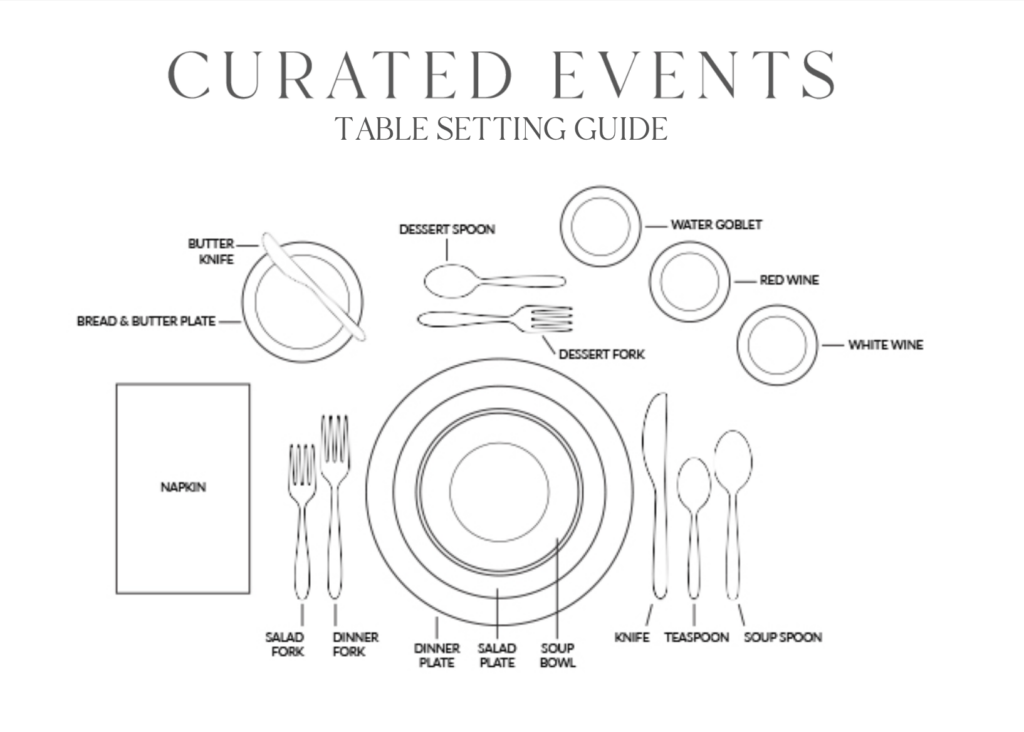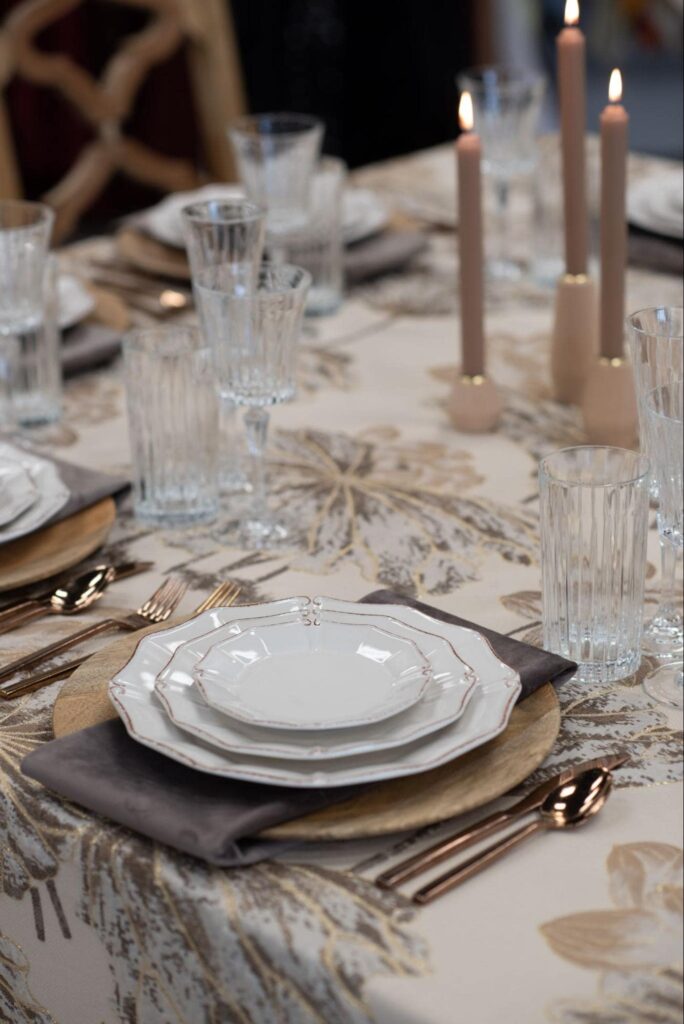The table setting is a time-old tradition that dates back centuries. It’s a way of formalizing meal time, adding flair, and giving gatherings around a table the respect they deserve. Yet, in the same breath, table setting has slowly become a forgotten art. Today’s world of casual dining and fast food has led to drastically lowered standards, leading us to under appreciate the true elegance that proper setup can bring to a dining experience.

In this guide, we’ll discuss the basics of table setting, from the parts that make up a setting to best practices for different occasions.
Why Take The Time To Set Your Dinner Table?
The art of table setting has slowly declined in practice over the past decades. Once a common standard in households, it’s now only really seen at organized events and gatherings. You could blame this downfall on several things – like changes in eating styles, social norms, or a simple loss of interest in tradition. But whatever the case, the fact remains clear that few seem to appreciate it anymore. So why care?
Despite its relevance to everyday individuals, table setting remains an essential skill to know and practice. It teaches respect and gratitude, which are two important principles that will always be relevant in social life. Further, the table setting offers a sense of decoration and style which can add an extra touch to any occasion. It shows that you took the time to consider the event and care about the people there.
The table setting is also an important part of etiquette, which can set the tone for dinner. It can be a way to set boundaries and expectations for the evening’s food, people, and atmosphere. When practiced correctly, it can help to make dinner more enjoyable and memorable.
Table Setting: The Fundamentals
The table setting is seldom taught in schools, so it’s completely okay to feel a need for direction when planning your event. The process is actually quite simple; all it takes is some knowledge of the basics to get started. We’ll review them piece by piece below.
The Parts Of A Place Setting
First, let’s go over the items you’ll find in a traditional table placement.

Regardless of the occasion, place settings should always consist of the following:
Plate – This is the main item that will be used to hold food throughout the dinner. Plates can come in various varieties, including appetizer, salad, entrée, and dessert plates. Charger plates are a larger accessory that can underlayer the regular plate and add an extra touch of style.
Bowls – Bowls are often used for soup or other dishes. Typically, the soup bowl is placed on top of the dinner plate.
Glassware – A standard place setting will include at least two glasses: a water glass and a stemmed glass for wine.
Utensils – This includes the knife, fork, and spoon. Depending on your occasion, multiple types of each can be used for different meal courses.
Napkin – This item is included to wipe your hands and face while eating. Most events opt for fabric varieties, which can be styled with the table’s overall décor.
Best Practices
While it’s important to note that these rules can vary with context, there are some basic protocols everyone should follow when setting the table for an event.
The first is how things are laid out across the table. It’s important to consider the gathering size and the number of people who can realistically dine from the same surface. If you’re expecting a large group, it’s worth spreading them out across multiple tables rather than trying to fit all of their places into one. Each guest should have at least two feet of space between them and the next person.
As for the dinnerware, pieces should be arranged in the same order for everyone. This includes the plate, napkin, utensils, and beverage glasses. They should also be spaced apart from each other according to their size and use.
Bigger items should be placed farther away, while smaller ones can be closer together. The layout can vary depending on how formal your event is, which we’ll get into next.
How To Set Tableware For Your Event Based On Formality
While the tableware setting generally follows a core set of conventions, the details that go into it can vary depending on the type of event you’re hosting. Some gatherings will require more details – and pieces – than others.
The following is a breakdown of the table setting types that exist for different event formalities.
Basic Table Setting
The basic table setting includes a plate, napkin, knife, fork, and spoon. It’s the most common type of dining arrangement and is appropriate for informal gatherings.
How to do it:
- Place the plate a few inches from the table’s edge
- Place the napkin to the left of the plate, or on top of it
- Place a fork (tines facing up) to the left of the plate
- Place a spoon and knife on the far right side of the plate, with the knife closest to it with the sharp side facing toward the palte
Special Considerations
This covers everything we discussed earlier regarding fundamental tableware. Nothing more, nothing less. However, step one can be skipped to allow guests to serve themselves if you are hosting a buffet.
Casual Table Setting
Casual table spreads are intended for gatherings that involve some level of formality but need easy and fast rules. This type of table setting adds a few elements to the basics, such as salad and dessert forks, extra glasses, and side plates.

How to do it:
- Place the plate two or three inches from the table edge
- Place the napkin to the left of the plate, or fold it and put it on top of the plate
- Place a salad fork and dessert fork (tines facing up) to the left of the plate
- Place a knife to the right of the plate, facing inwards
- Place a soup spoon on the far right side beside the knife
- Place a dessert spoon above the plate with the handle pointing to the right
- Place a drinking glass and/or wine glass on the upper right side of the plate
Formal Table Setting
Formal table setting involves going all out on a table’s presentation. Its surface, like the guests attending the event, should be dressed to look the part – affluent, cohesive, and elegant. This type of setting requires the most pieces, such as multiple glasses for champagne and wine, a soup spoon, and additional dinnerware for appetizers or desserts.
How to do it:
- Place a charger plate two or three inches out from the table’s edge, layered with the dinner plate
- Stack any and all additional plates and bowls in order of size on top of the charger plate
- Place a folded napkin on the left side of the charger plate
- Place a bread plate and butter knife on the upper left side of the charger plate
- Place a salad fork and dessert fork (tines facing up) to the left of the plate, in order of small to large
- Place a soup spoon horizontally above the plate with its handle pointing to the right
- Place a knife to the right of the plate, facing inwards
- Place a teaspoon on the far right side beside the knife
- Place multiple glasses on the upper right side of the plate, including a water glass, wine, and champagne glasses
- Add a wine decanter and butter dish to the top left side if appropriate
The table setting is an important part of any event, from casual to formal. Knowing how to properly set the table for every case is key to ensuring your guests have an enjoyable time. With the guidelines outlined above, you’ll be sure to impress guests of any type.

FAQs
What is a charger plate?
A charger plate is a large, decorative plate that acts as the base for the table setting. It adds an elevated aesthetic and is generally used to decorate the table while keeping it clean and food warm.
What is the difference between a formal and casual table setting?
The main differences between a formal and casual table setting are the number of pieces used and their placement. A casual table setting requires fewer pieces but still follows the fundamental rules for tableware placement. A formal table setting, on the other hand, requires more pieces and is much more intricate. It also often includes additional items such as wine glasses or decanters.
Where can I get a tableware set?
Intricate tableware sets are something only some have lying around, so they usually need to be purchased or rented. Curated Events has the most extensive inventory of tabletop ware, with both depth of inventory and breadth of designs and aesthetics. We can’t wait to create a custom tabletop look with you!

